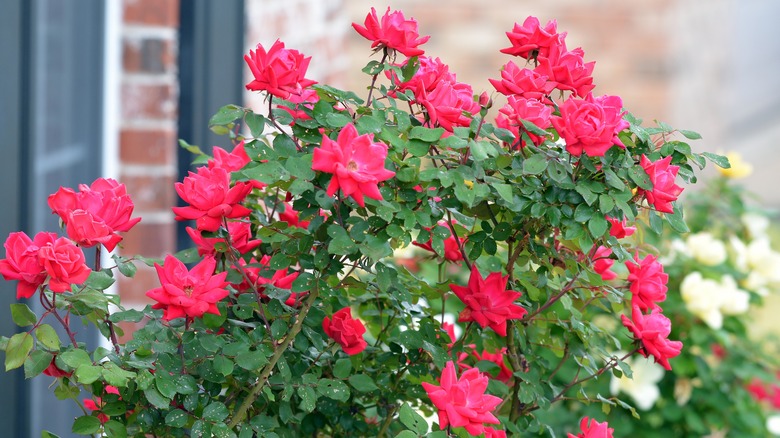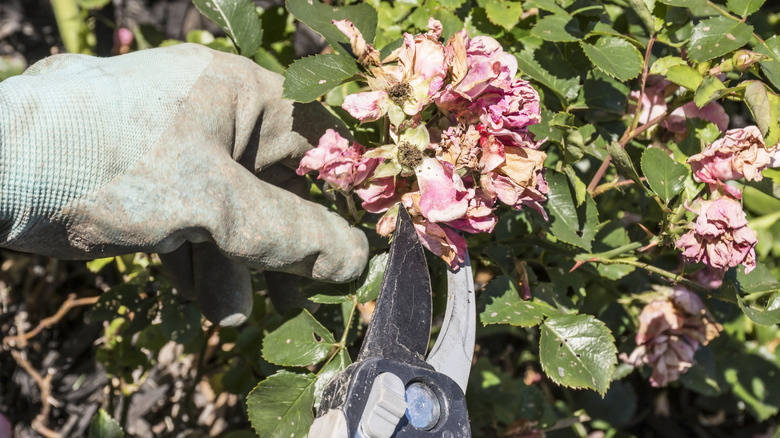Should You Deadhead Your Knock Out Roses In Summer?
We may receive a commission on purchases made from links.
Who doesn't love roses, especially the famously easy-to-care-for Knock Out series? Not only are Knock Out roses beautiful, tough, and hardy in USDA zones 5 through 9, but they're also prolific bloomers. While many roses require regular deadheading to encourage repeat blooms, Knock Out roses can bloom all summer even without that extra work. However, while deadheading isn't strictly required for Knock Out roses, it can certainly still be done in summer if you want to see new blooms grow back faster or if you prefer your plants to have a slightly neater appearance.
Despite only being introduced in 2000, Knock Out roses are now one of the most popular rose varieties in North America thanks to their vigor and ease of care. One of the major selling points of Knock Out roses is their self-cleaning ability. This means that, unlike other plants that hold onto dead blooms, the Knock Out's spent bloom stems will simply turn brown and fall off, allowing new buds to grow in their place. As a result, they can bloom all summer even without deadheading. However, as stated, it can still be worth it to deadhead these bushes. As Elena Williams of the American Rose Society says when talking about Knock Out roses, "Snipping off spent blooms during the growing season will encourage quicker re-blooming," (per Martha Stewart). If you want to see new blooms faster, here's how to deadhead these plants.
How to deadhead Knock Out roses
Unlike pruning, which often involves removing up to half of a plant's height and should largely happen in late winter or early spring before the roses break dormancy, deadheading refers only to removing spent flowers to encourage more blooms and growth. For some repeat blooming roses, deadheading is essential for keeping the plant blooming all season. While deadheading is an entirely optional step with Knock Out roses, the process is the same as it would be with any other rose bush.
You should deadhead roses whenever a flower has passed its prime during the blooming season, which largely happens in the summer. To deadhead the plant, simply cut off old blooms and the sets of three leaflets that are growing just below them. This should result in cutting just above a set of five leaflets. Ideally, the cut should be made at a 45-degree angle to discourage water and disease from pooling on or in the cut. You can simply discard the old blooms and wait for the new ones to emerge.
Tips for deadheading Knock Out roses
While proper deadheading will not harm Knock Out roses, there are some important tips to keep in mind. Be sure to use sharp pruning shears or scissors that can cleanly cut through stems instead of crushing them. Further, as roses can be quite prone to disease, remember to clean and disinfect your shears or scissors between rose bushes to avoid spreading fungi, viruses, and bacteria from plant to plant. While summer isn't the time for serious pruning, and it is generally best to prune roses in early spring or late winter for a stunning spring display, don't be afraid to remove damaged or diseased branches during the summer as well, as they could be negatively impacting your plant's health.
Furthermore, it's not just the rose bush's health and protection you should keep in mind while deadheading — also consider your own safety. Knock Out roses, like most other types, are notorious for their thorns, so gloves are a must. If possible, opt for a pair of rose gardening gloves, which will not only protect your hands but also your arms. These can be purchased from retailers such as Home Depot for under $15.


